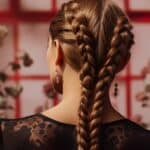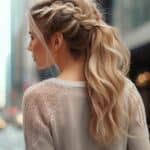Regarding hair care, everyone has tips and tricks for achieving perfect locks. However, not everything we hear about hair care is accurate, and some of these widely-believed hair myths could be doing our tresses more harm than good. In this article, we’ll explore some of the most common hair myths that continue to persist, debunk the falsehoods, and reveal the truth that lies beneath.
It’s crucial to separate fact from fiction to maintain hair health and avoid wasting time, effort, and money on ineffective hair care practices. Throughout our journey of dispelling these myths, we’ll delve into misunderstandings about hair growth, shampooing and conditioning, styling techniques, maintaining overall hair and scalp health, and much more. With the correct information, you can make informed decisions about how to best care for your hair, avoid unnecessary damage and confidently navigate the often confusing world of hair care.
Key Takeaways
- Uncover the truth behind typical hair growth, styling, and care myths.
- Learn to differentiate between effective hair practices and damaging habits.
- Embrace informed decision-making for optimal hair and scalp health.

Stimulating Hair Growth Myths
Plucking for Regrowth
One common myth about stimulating hair growth is that plucking out a hair will cause it to grow back thicker and faster. However, this is not true. Plucking can often damage the hair follicle, potentially leading to thinner and slower hair growth or even hair loss. It is essential to remember that consistent plucking or waxing may weaken the hair follicle over time, which may ultimately hinder hair growth. It is best to avoid plucking and try gentle hair care practices to maintain healthy hair growth.
Frequent Trims for Length
Another popular myth about hair growth is that frequent trims can help hair grow longer and faster. The truth is that hair growth occurs at the roots, not the ends. Trimming hair regularly may help maintain healthy hair by preventing split ends, but it does not directly impact hair growth rate. Hair typically grows about half an inch per month, regardless of how often it is trimmed.
It is important to note that getting regular trims can indirectly help hair appear longer and healthier in the long run by preventing breakage from split ends traveling up the hair shaft. However, this does not mean hair will grow more quickly. To support healthy hair growth, focus on a balanced diet, proper hair care routines, and stress management.
Shampoo and Conditioner Myths
Shampooing Too Often
It’s a common belief that shampooing too often can harm your hair. However, the truth is that shampooing frequency depends on individual hair types and scalp conditions. Daily shampooing might be necessary for those with oily hair or who engage in activities causing sweat and dirt buildup. On the other hand, those with dry hair or sensitive scalps may benefit from shampooing less frequently. The key is to find a balance that works best for your hair type and lifestyle.
Conditioner Leads to Oily Hair
Another myth is that conditioner causes oily hair. In reality, the purpose of a conditioner is to moisturize and nourish the hair, leaving it smooth and manageable. Those with naturally oily hair might benefit from using a lightweight conditioner formulated for their hair type. It’s important to remember that when applying conditioner, focus on the mid-lengths to ends of the hair, avoiding the scalp area. This will help reduce the chances of weighing down the hair and causing an oily appearance.
Natural Oils as a Substitute
Many believe relying on their hair’s natural oils is enough to maintain clean, healthy hair. While it’s true that your scalp produces natural oils (sebum) to protect and moisturize the hair, these oils can build up along with dirt and product residue, leading to greasy or weighed-down hair. A gentle shampoo and conditioner combination appropriate for your hair type can help maintain a balance of natural oils while keeping your hair clean and free from buildup.
Understanding the distinctions between these myths and the actual facts can help you navigate your hair care routine, ensuring you maintain healthy, clean hair that suits your specific needs. Don’t be afraid to adjust your shampooing frequency based on your hair type and lifestyle, select a conditioner suitable for your hair, and strike a balance between utilizing natural oils and cleansing your hair to prevent buildup.
Hair Styling Myths
Heat Styling Causes Damage
While it’s true that excessive heat styling can lead to hair damage, using heat styling tools in moderation and with proper protection can help minimize any potential harm. To protect your hair from heat damage, using a heat protectant spray or serum before applying heat is essential. It’s also important to choose the appropriate temperature setting for your hair type and avoid excessive use of heat styling tools.
Air-Drying vs. Blow-Drying
There’s a common belief that air-drying is always better than blow-drying. However, the truth is more nuanced. Air-drying can sometimes trap moisture within the hair strands, causing hygral fatigue and weakening the hair. In contrast, blow-drying can help seal the cuticle, giving the hair a smoother appearance.
To achieve the best results, it’s important to find a balance between the two drying methods. If you blow-dry, use a medium or low heat setting and keep the dryer at least six inches from your hair. Alternatively, partially air-dry your hair before finishing with a quick blow-dry to reduce the amount of heat exposure.
Tight Hairstyles and Hair Loss
Tight hairstyles, such as ponytails, braids, and extensions, can stress the hair strands and scalp, leading to hair loss. This type of hair loss, known as traction alopecia, occurs when consistent tension is applied to the hair, causing it to weaken and eventually break or fall out.
To minimize the risk of hair loss due to tight hairstyles, try the following:
- Avoid pulling your hair back too tightly, and vary the location of your ponytail or bun to reduce the pressure on one specific area.
- Opt for loose braids instead of tightly woven styles, and avoid wearing them for extended periods.
- Be cautious with extensions, as they can add weight and tension to your hair. It’s best to consult a professional hairstylist when considering extensions to ensure they’re properly installed and maintained.
Myths About Hair Health
Brushing for More Volume
It is a common belief that brushing your hair frequently can increase volume. However, this is not entirely true. While brushing can help distribute natural oils from the roots to the tips, excessive brushing can cause more harm than good. Over-brushing can lead to hair breakage, split ends, and even weakening hair follicles. Understanding your hair type and using the appropriate brush to avoid causing damage is essential. In general, brushing your hair only when necessary to untangle knots or style your hair to minimize mechanical stress is recommended.
Cold Water Makes Hair Shinier
Another popular myth is that rinsing your hair with cold water can make it shinier. The belief is that cold water will close the hair cuticles, leading to a smoother hair shaft and increased shine. However, the water temperature does not significantly affect the state of the hair cuticles. In reality, maintaining the moisture and conditioning of the hair is critical for achieving glossy and healthy-looking hair. It is essential to use quality hair care products that suit your hair type and avoid harsh chemicals that can strip the hair of its natural oils. While using cold water may not harm your hair, achieving shininess is unnecessary. Neutral to moderately warm water is sufficient during your hair care routine.
Dirty Hair Grows Faster
The misconception that dirty hair grows faster is based on the idea that less frequent washing and fewer styling routines might prevent hair damage and breakage. Although skipping excessive heat styling and hair manipulation can help maintain hair health, dirty hair does not directly lead to faster growth. Your genetics, overall health, and hair care routine primarily determine hair growth. Greasy, dirty hair can also clog hair follicles and lead to scalp issues, negatively impacting hair health. Maintaining a regular cleansing and conditioning routine that strikes a balance between keeping your hair clean and not stripping it of its natural oils and moisture is vital. This, in turn, will help promote healthier hair growth.
Graying Hair Myths
Plucking Grays Multiplies Them
A common myth surrounding gray hair is that plucking one gray strand will cause multiple gray hairs to grow in its place. This is not true. When you pluck a strand of hair, only one new hair will grow from that follicle. The color of the new strand depends on the melanin-producing cells in that hair follicle. If those cells are still active, the new hair will have pigment; if not, the hair will grow gray. Plucking gray hair does not cause more gray hairs to grow, but it can potentially damage the hair follicle, resulting in potential issues with hair growth in the future.
Stress Accelerates Graying
It’s widely believed that stress can speed up the graying process. While there is some truth to this, the connection between stress and graying is not as straightforward as it may seem. Graying hair is primarily determined by genetics. However, lifestyles, including long-term stress, may contribute to graying.
When under stress, the body may produce higher amounts of cortisol, a hormone linked to oxidative stress. Oxidative stress can affect melanin-producing cells, which might lead to the premature graying of hair. It’s essential to note that stress is only one factor among many others, including genetics, nutritional deficiencies, and even smoking, that can influence graying hair.
In summary, graying hair is primarily a result of genetics, aging, and a decline in melanin production. Myths such as plucking grays, multiplying them, or stress being the sole cause of graying hair are inaccurate. While stress may contribute to the graying process, it is only one factor that can influence this natural aging process.
Misconceptions About Scalp Health
Dandruff Indicates Dry Scalp
A common misconception is that dandruff directly results from a dry scalp. However, dandruff is often caused by a fungal infection, inflammation, or even psoriasis and eczema. On the other hand, a dry scalp typically presents itself with small, white, non-oily flakes. Both conditions require different treatments, so it’s essential to consult a dermatologist for an accurate diagnosis.
Coconut Oil Solves All Scalp Issues
While coconut oil is hailed for its numerous benefits, it is not a one-size-fits-all solution for all scalp-related issues. Coconut oil’s moisturizing properties may help with dry scalp, but its effectiveness for other conditions, such as bacterial and fungal infections or inflammation, has not been conclusively proven. It is crucial to identify the root cause of a scalp problem and choose appropriate treatments based on a dermatologist’s recommendation.
Wearing Hats Causes Hair Loss
Another widespread myth is that consistently wearing hats can lead to hair loss. While a tight hat could cause friction and damage to hair, there is no direct link between wearing hats and hair loss. Hair loss usually occurs due to genetics, hormonal imbalances, or certain underlying health issues. Though avoiding hats altogether for scalp health is unnecessary, it’s still a good idea to ensure proper fit and hygiene regarding headwear.
Common Hair Breakage Myths
Towel Drying Causes More Friction
It is a common belief that towel drying your hair can cause more friction and lead to hair breakage. While it’s true that rubbing your hair vigorously with a towel can cause damage to the hair cuticle, proper technique can minimize friction and prevent breakage. Instead of rubbing, gently squeeze and pat your hair dry with a soft, absorbent towel. This ensures you are not subjecting your hair to unnecessary friction and reduces the risk of breakage.
All Hair Products Cause Damage
Another myth surrounding hair breakage is that all hair products cause damage. It’s essential to understand that not all hair products are created equal, and some can provide protection and nourishment to your hair. For example:
- Shampoos: It is not the use of shampoos that causes damage, but rather the frequency and specific types used. Choose a gentle, sulfate-free shampoo and avoid over-washing your hair to prevent dryness and breakage.
- Conditioners: These products can be very beneficial for hair health, as they provide essential proteins and hydration that help support the hair shaft, preventing breakage.
- Heat protection products: Regular heat styling tools can weaken the hair and cause breakage. However, heat protection sprays and serums provide a barrier that protects hair from heat damage.
In conclusion, not all hair products cause damage. Selecting suitable products for your hair type and following proper application techniques to ensure the best results and prevent hair breakage is crucial.
Popular Hair Texture Misconceptions
All Hair Textures Need the Same Care
It’s a common misconception that all hair textures require the same care and treatment. In reality, each hair texture has its own needs and characteristics. Hair textures vary from straight to wavy, curly, and kinky-coily, each with a specific hair follicle shape. This diversity translates to different levels of sebum distribution along the strand, affecting the hair’s moisture and overall health.
Straight hair, for instance, typically receives a more even distribution of sebum, resulting in healthier and shinier locks. On the other hand, curly and kinky-coily hair textures often struggle with dryness due to the uneven distribution of sebum along the strand. Consequently, these hair types require more hydration and care to maintain their natural texture and prevent damage.
Curling Leads to More Split Ends
Another popular hair myth is that curling hair leads to more split ends. The truth is that it’s not the act of curling itself that causes split ends, but rather how the hair is curled and the frequency at which it’s done.
Curling tools like flat irons, curling wands, and heated rollers, when used on high heat settings and without proper heat protection, can cause damage to the hair shaft, leading to frizzy hair and split ends. Furthermore, excessive tension while styling can weaken hair, making it more prone to breakage, thinning, and split ends.
To avoid these issues, taking a few precautions when styling hair is essential. Always use a heat protectant before applying heat to the hair, choose a suitable temperature setting, and avoid tugging or pulling the hair too forcefully. Moreover, embracing your hair’s natural texture and giving it a break from heat styling from time to time can significantly reduce the chances of damage.
Frequently Asked Questions
Does cutting hair make it grow faster?
No, cutting your hair does not make it grow faster. This is a common myth. Hair growth occurs at the roots, not at the ends. Regular trimming can help maintain healthy hair by removing split ends, but it does not directly affect the growth rate.
Is frequent hair oil application beneficial for growth?
Hair oil can be beneficial for certain hair types and conditions. It can help moisturize and nourish the hair, protecting it from breakage and promoting overall health. However, excessive oil application can potentially weigh down hair and lead to buildup, which may be counterproductive for some individuals.
Do hair serums help with hair health?
Depending on their ingredients and specific functions, hair serums can play a role in maintaining and improving hair health. Some serums contain nourishing and protective ingredients, such as vitamins, proteins, or oils, which can contribute to hair strength and resilience. It is important to choose a serum that targets your specific hair needs and concerns.
Are hair products necessary for good hair growth?
Using hair products can help support good hair growth, but they are not necessary in every case. Maintaining a balanced diet, staying hydrated, and establishing a proper hair care routine can promote healthy hair growth. Hair products should be tailored to an individual’s hair type and specific concerns for optimal results.
Does having greasy hair promote growth?
Having greasy hair does not necessarily promote hair growth. Excess oils on the scalp and hair may be due to overactive sebaceous glands, which could lead to clogged hair follicles and hinder hair growth. It is important to find a balance in scalp care to prevent the overproduction of oils and maintain a healthy environment for hair growth.
How important is scalp health for hair growth?
Scalp health is vital for hair growth, as the hair follicles reside on the scalp. Maintaining a clean, balanced, nourished scalp creates an environment conducive to growth. Dandruff, inflammation, or clogged follicles can negatively impact hair growth. A proper hair care routine that addresses specific scalp concerns can contribute to a healthier scalp and stronger hair growth.





